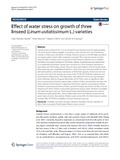| dc.description.abstract | Linseed (Linum usitatissimumL.) is an annual oil crop that accounts for approximately 1% of the world’s oilseed supplies. It produces seeds that are rich in the health-promoting ω-3 fatty acid, α-linolenic. In Kenya, linseed is grown in the Rift Valley and Western regions, places which often experience drought. This study was aimed at evaluating the effect of water stress on growth of three linseed cultivars and to establish the extent of drought tolerance in the three cultivars. A greenhouse pot experiment in a completely randomized design was conducted at Jomo Kenyatta University of Agriculture and Technology, Kenya. The pots were well watered until the fourth week when watering was completely withheld to a half of the pots (stressed) while the other half (well watered control) was maintained at 90 % field capacity. Destructive harvesting was done when the stressed pots were at 90, 70, 60, 50, 40 % field capacities and at permanent wilting point. The experiment was replicated thrice and was repeated twice (February–May and August–November 2014). There were no significant differ
ences in production of leaves, plant height, number of tillers and biomass between the three varieties in both seasons. Subjecting the linseed varieties to permanent wilting resulted in reduced production of leaves, growth in height, production of tillers and dry weight by 20–40 %. Decline in all growth parameters begun when 30–80 % of available soil water had been used up. There existed linear relationships between the various evaluated growth parameters. These relationships were not influenced either by the water status of soil or the varieties. Relative water content for the three linseed varieties
declined after 25–67 % of available soil water had been used up. | en_US |

